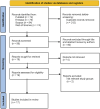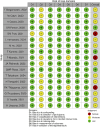Cruciate-Retaining Implants Do Not Provide a More Natural Joint Feeling Than Cruciate-Substituting Implants in Total Knee Arthroplasty: A Systematic Review and Meta-Analysis
- PMID: 40777211
- PMCID: PMC12324053
- DOI: 10.2106/JBJS.OA.25.00136
Cruciate-Retaining Implants Do Not Provide a More Natural Joint Feeling Than Cruciate-Substituting Implants in Total Knee Arthroplasty: A Systematic Review and Meta-Analysis
Abstract
Background: The Forgotten Joint Score (FJS) is a patient-reported outcome measure developed to assess joint awareness, potentially differentiating between "good" and "excellent" outcomes. Prosthetic designs, specifically cruciate-retaining (CR) and cruciate-substituting (cruciate sacrificing/substituting [CS]) implants, may influence joint awareness due to differences in posterior cruciate ligament (PCL) preservation. Our objective was to compare the joint awareness outcomes, measured by the FJS, between CR and CS implants in total knee arthroplasty (TKA).
Methods: A systematic review and meta-analysis were conducted following PRISMA guidelines. Scopus, PubMed, Embase, and Web of Science were searched up to March 2024 without date or language restrictions. Studies comparing CR and CS implants reporting FJS outcomes were included. Data extracted included study characteristics, patient demographics, intervention details, follow-up durations, and FJS scores. Risk of bias was assessed using the Risk of Bias in Nonrandomized Studies of Intervention-I tool. A random-effects meta-analysis using Hedges g was performed, with sensitivity analyses and meta-regression to explore heterogeneity.
Results: Seventeen cohort studies involving 4,245 patients were included. The meta-analysis demonstrated that CS implants were superior to CR implants in terms of FJS (Hedges g = -0.39; p = 0.018), indicating a small to medium effect size favoring CS designs. High heterogeneity was observed (I2 = 95.69%). Sensitivity analyses yielded similar results, and meta-regression did not identify significant sources of heterogeneity.
Conclusion: CS implants are associated with superior joint awareness compared with CR implants in TKA, as measured by the FJS. Despite the theoretical advantage of PCL preservation, CR implants did not demonstrate better joint awareness. The findings should be interpreted with caution due to study heterogeneity and limitations in study design. Further high-quality randomized controlled trials are necessary to confirm these results.
Copyright © 2025 The Authors. Published by The Journal of Bone and Joint Surgery, Incorporated. All rights reserved.
Conflict of interest statement
The protocol of this study was prospectively registered in PROSPERO (CRD42024553420). Disclosure: The Disclosure of Potential Conflicts of Interest forms are provided with the online version of the article (http://links.lww.com/JBJSOA/A866).
Figures




Similar articles
-
Retention versus sacrifice of the posterior cruciate ligament in total knee arthroplasty for treating osteoarthritis.Cochrane Database Syst Rev. 2013 Oct 11;2013(10):CD004803. doi: 10.1002/14651858.CD004803.pub3. Cochrane Database Syst Rev. 2013. PMID: 24114343 Free PMC article.
-
Kinematic Alignment Does Not Result in Clinically Important Improvements After TKA Compared With Mechanical Alignment: A Meta-analysis of Randomized Trials.Clin Orthop Relat Res. 2025 Jun 1;483(6):1020-1030. doi: 10.1097/CORR.0000000000003356. Epub 2025 Jan 21. Clin Orthop Relat Res. 2025. PMID: 39842026
-
Mobile bearing vs fixed bearing prostheses for posterior cruciate retaining total knee arthroplasty for postoperative functional status in patients with osteoarthritis and rheumatoid arthritis.Cochrane Database Syst Rev. 2015 Feb 4;2015(2):CD003130. doi: 10.1002/14651858.CD003130.pub3. Cochrane Database Syst Rev. 2015. PMID: 25650566 Free PMC article.
-
Systemic pharmacological treatments for chronic plaque psoriasis: a network meta-analysis.Cochrane Database Syst Rev. 2017 Dec 22;12(12):CD011535. doi: 10.1002/14651858.CD011535.pub2. Cochrane Database Syst Rev. 2017. Update in: Cochrane Database Syst Rev. 2020 Jan 9;1:CD011535. doi: 10.1002/14651858.CD011535.pub3. PMID: 29271481 Free PMC article. Updated.
-
Systemic pharmacological treatments for chronic plaque psoriasis: a network meta-analysis.Cochrane Database Syst Rev. 2021 Apr 19;4(4):CD011535. doi: 10.1002/14651858.CD011535.pub4. Cochrane Database Syst Rev. 2021. Update in: Cochrane Database Syst Rev. 2022 May 23;5:CD011535. doi: 10.1002/14651858.CD011535.pub5. PMID: 33871055 Free PMC article. Updated.
References
-
- Wylde V, Dieppe P, Hewlett S, Learmonth ID. Total knee replacement: is it really an effective procedure for all? Knee. 2007;14(6):417-23. - PubMed
-
- Murray DW, MacLennan GS, Breeman S, Dakin HA, Johnston L, Campbell MK, Gray AM, Fiddian N, Fitzpatrick R, Morris RW, Grant AM; KAT group. A randomised controlled trial of the clinical effectiveness and cost-effectiveness of different knee prostheses: the knee arthroplasty trial (kat). Health Technol Assess. 2014;18(19):1-235. vii-viii. - PMC - PubMed
-
- Nam D, Nunley RM, Barrack RL. Patient dissatisfaction following total knee replacement: a growing concern? Bone Joint J. 2014;96-b(11 suppl A):96-100. - PubMed
-
- Bonnin MP, Basiglini L, Archbold HA. What are the factors of residual pain after uncomplicated tka? Knee Surg Sports Traumatol Arthrosc. 2011;19(9):1411-7. - PubMed
Publication types
LinkOut - more resources
Full Text Sources
